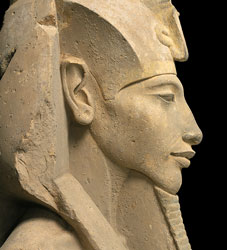

 by Andre van der Wateren
translation:
Jacqueline Kuijpers
A
heretic, a dangerous madman to the State, a megalomanic egoist and a
revolutionary. But also a genius renewer of art, founder of monotheism, pacifist
en probably the father of the most famous pharaoh, Tutankhamen. The National
Museum of Antiquity at the Rapenburg in
Leyden, Holland, focusses under the title “Pharaohs of the Sun” on the
many aspects of the short but stormy reign of Amenhotep IV, better known as
Akhenaten.
Egypt
was at the time of the New Kingdom (1539-1075 B.C.) at the height of its power.
The country stretched itself from Southern Nubia unto Persia. Money, exotic
products and new ideas about art and religion floated into the country. Pharaoh
Amenhotep III profited of this. In many aspects he was an unconventional king.
This has been made most clear by the erection of the famousÂ
so called colossal statues
of Memnon. These giants donÂ’t have the idealised form as known from other
pharaohs, but clear expressive, divine features. In ancient Egypt, this was
unprecendented. Kings were not deified until after their death; never before had
a pharaoh dared to proclaim his deity while he was still alive.
Â
Â
When
his son Amenhotep IV is crowned in 1353 B.C., he appears to be more radical than
his father was. At the temple complex of Karnak, sanctuary of de tradional
highest god Amun he erects within a very short time at least four temples, all
dedicated to one god, Aten. The god is no longer depicted as an animal orÂ
a combination of animal and human form, but as an abstract solar disc.
From the disc sunbeams are raying with at their end hands which enclose
everything shone upon by the sun and created and governed by the god. He also
erects giant statues of himself and his wife Nefertiti.
This
style breaks off with everything the Egyptians had ever seen before. Statues are
plain caricatural; they almost seem to be, unrespectfully spoken, Disney
cartoons: thin, long limbs, big bellies and breasts, swollen lips and slant eyes.
 
In
the fifth year of his reign, Amenhotep IV changes his name into Akhenaten (“He
who is usefull to Aten”). It becomes clear to him, that he has caused such an
enormous fraction with his ideas, that he has to leave Thebes, the bulwark of
Amun. Exactly between the two old capitals Thebes and Memphis, he builds a new
capital, Akhet-Aten (“Horizon of Aten”), close to the actual town of Amarna.
Within a very short time palaces, temples, houses and storerooms are knocked out
of the virgin desert soil. At its heyday the city contains 20,000 to 50,000
inhabitants. In the National Museum of Antiquity in Leyden you can see an
enormous 18 square meter model of Akhet-Aten and by means of computerized
animations, it seems if one roams the more than 3500 year old city.
 
Â
Fiasco
Akhenaten
unchains an iconoclasm, he orders the temples of the tradional gods to be closed
and their names to be erased. Especially the highest god Amun has to pay. The
first monotheistic faith has become fact. Or not? Akhenaten namely also has his
wife and children worshipped as if they were gods, a phaenomenon discreetly
started by his father during the last years of his reign.
In
spite of Akhenatens dedication and devotion, the cult of Aten turns out to be a
fiasco. Outside the new capital, the new faith doesnÂ’t settle down, common
Egyptians remain faithful to their old gods. They miss the rituals and
festivals, which lead their dayly life. Apart from that, Aten gives mortals no
comfort in the form of an afterlife. After all, Osiris, the god of resurrection,
who rules the underworld, has been banned too.
Akhenaten
dies in the seventeenth year of his reign in 1336 B.C. At once, the reverse of
all changes by him is started. This probably starts already under the reign of
Nefertiti, who herself, after her husbandÂ’s death, reigned as a pharaoh for a
short period. In 1332 B.C., at the age of nine, Tutankhaten ascends to the
throne. The young pharaoh, probably the son of Akhenaten and his minor wife Kiya,
has little power. In fact, the country is ruled by experienced ministers, like
treasurer Maya and army high-commander Horemheb.
Tutankhaten
soon after changes his name into Tutankhamun. This puts a quick and final end ti
his father’s “herecy”. Thebes becomes again the religious capital of Egypt
and Memphis the political one. Amun be-comes the highest god once more.
Akhet-AtenÂ’s inhabitants leave the city very fast; after that, the city of the
Sun lays totally wasted and dissapears in the desert sand. Temples and statues,
erected by Akhenaten, are used by later pharaohs for their building projects.
In
the, according to that period, poor grave of Tutankhamen the last remains from
the Akhet-Aten period have been found, like the back of the famous golden throne,
with the depiction of the Aten.
That
throne cannot be seen at the exhibition “Pharaohs of the Sun”. Nevertheless,
the exhibition at the Rapenburg in Leyden
has many beautiful things to show. Like there are the more than life size seated
statues of Maya and his wife Meryt and, of course, the 1,6 ton weighing
caricatural torso of Akhenaten from the Egyptian Museum in Cairo. As far this is
concearned, only one advice can be given: remember (Akhen)Aten en get up at
daybreak, for the lines in front of the till are long.
  pharaoh Tutanchamun
pharaoh Tutanchamun
Â
Rapenburg, Leyden, the Netherlands
